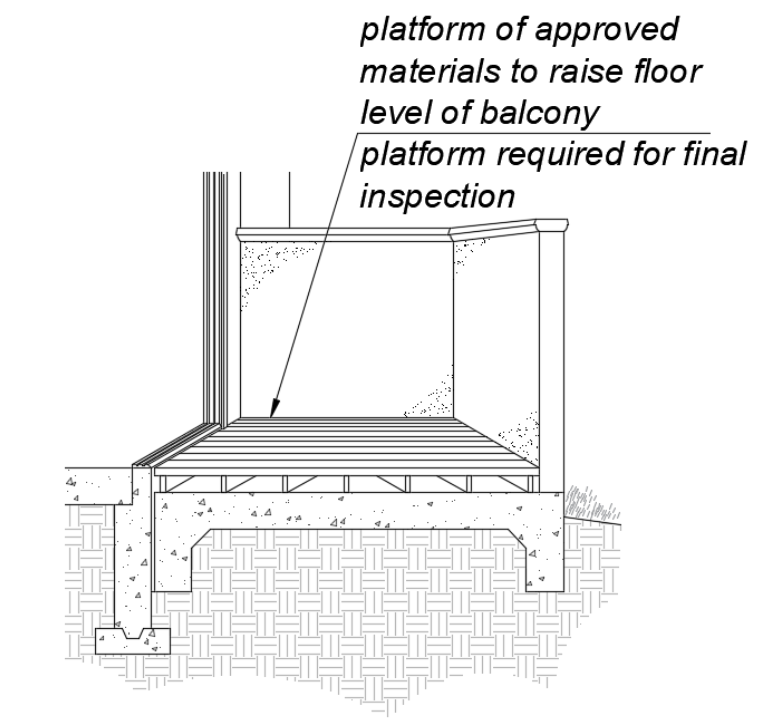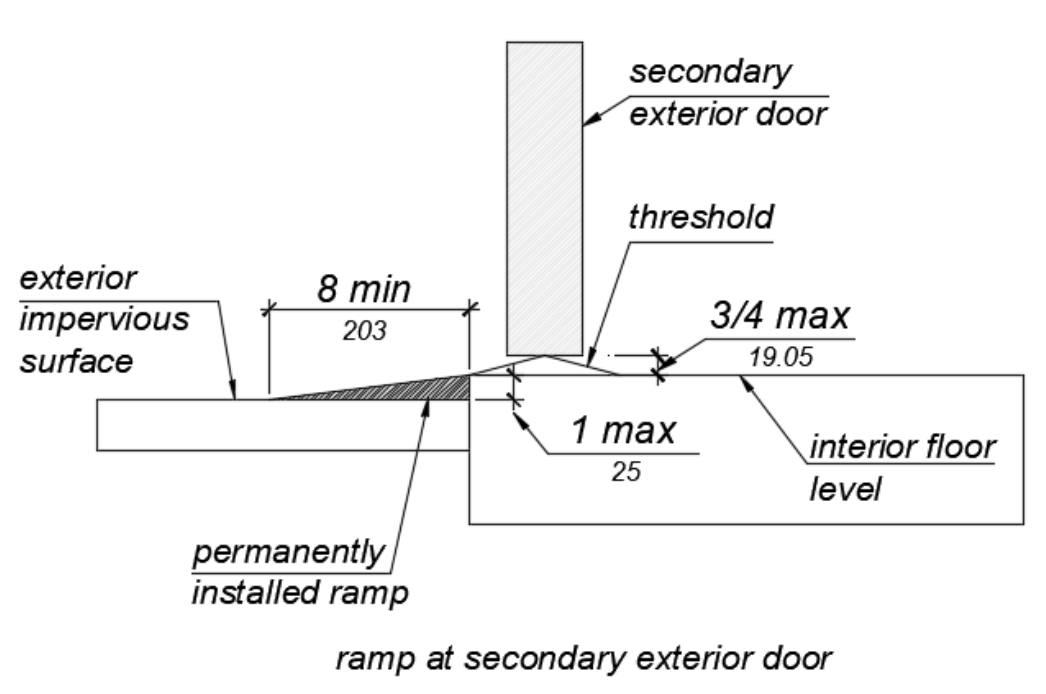2019 California Standards for Accessible Design Guide (effective January 1, 2020 with July 1, 2021 amendments)
11B-809.8 Doors.
Primary entry doors, required exit doors, secondary exterior doors and interior doors intended for user passage shall comply with this section and Section 11B-404.2. Doors to small mechanical closets specifically dedicated to furnaces or hot water heaters shall not be required to comply with this section.
Exceptions: At primary entry doors, required exit doors, secondary exit doors and interior doors the following exceptions apply:
1. The floor or landing at primary entry doors, required exit doors, and secondary exit doors where a change in elevation occurs between the interior and the exterior surface of the floor or landing, shall comply with the following:
a. Exterior landings of impervious construction (e.g., concrete, brick, flagstone) serving primary entry doors and required exit doors are limited to not more than 1/2 inch (12.7 mm) of change in height between floor surfaces. Changes in level shall comply with Section 11B-809.7.2.
b. Exterior landings of pervious construction (e.g., wood decking with spaces) shall be the same level as the interior landing, except that secondary exterior doors may have no more than 1/2 inch (12.7 mm) of change in height between floor surfaces. Changes in level shall comply with Section 11B-809.7.2.
c. Secondary exterior doors onto decks, patios, or balcony surfaces constructed of impervious materials (e.g., concrete, brick, flagstone) may have a maximum change in height from the interior landing of 4 inches (102 mm). Changes in height greater than 1/2 inch (12.7 mm) shall be accomplished by means of a ramp complying with Section 11B-405 or by means of a platform constructed to the level of the floor as illustrated in Figure 11B-809.8 (c).

FIGURE 11B-809.8 Ex. 1(c)
PLATFORM AT SECONDARY EXTERIOR DOOR.
d. Secondary exterior doors onto decks, patios or balcony surfaces constructed of impervious materials (e.g., concrete, brick, flagstone) may have a maximum change in height from the interior landing of 1 inch (25 mm), provided a ramp with a maximum slope of 1:8 is permanently installed as illustrated in Figure 11B-809.8 (d).

FIGURE 11B-809.8 Ex. 1(d)
RAMP AT SECONDARY EXTERIOR DOOR.
11B-809.8.1 Door Thresholds.
Secondary exterior door thresholds, including sliding door tracks, shall be 3/4 inch (19.1 mm) high maximum with a 1:2 maximum slope.
11B-809.8.2 Door opening force.
The opening force for primary entry exterior doors and secondary exterior doors shall be 8.5 pounds (38 N) maximum.
11B-809.8.3 Door maneuvering clearance.
-
At the dwelling unit side of the primary entry doors, secondary exterior doors, and required exit doors maneuvering clearances shall be 44 inches (1118 mm) minimum in length measured perpendicular to the face of the door in the closed position. The width of the maneuvering clearance shall extend 18 inches (457 mm) beyond the strike edge at the pull side of the door.
-
At interior doors maneuvering clearances shall be 42 inches (1067 mm) minimum in length on the both (sic) sides of the door measured perpendicular to the face of the door in the closed position. A 39 inch (991 mm) minimum length is allowed at interior doors when a clear opening width of 34 inches (864 mm) minimum is provided. The width of the maneuvering clearance shall extend 18 inches (457 mm) beyond the strike edge at the pull side of the door.
11B-809.8.4 Door signal devices.
Every primary entrance to a residential dwelling unit with adaptable features shall be provided with a door buzzer, bell, chime or equivalent. The activating mechanism shall be mounted 48 inches (1219 mm) maximum above the floor and connected to permanent wiring.

User Comments/Questions
Add Comment/Question